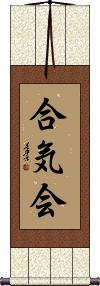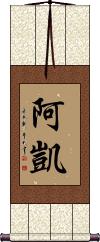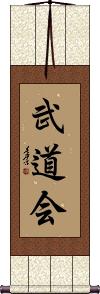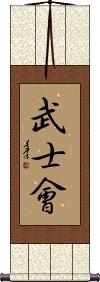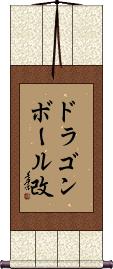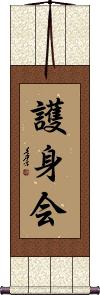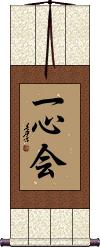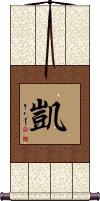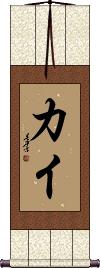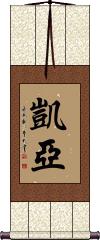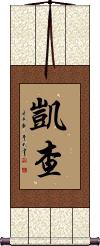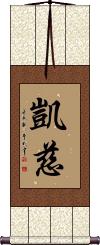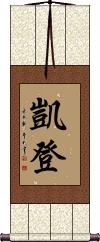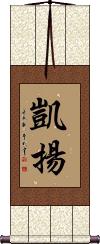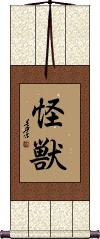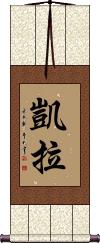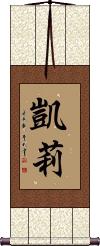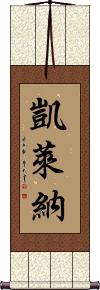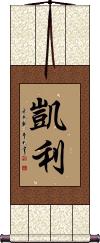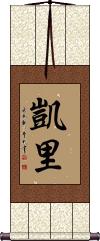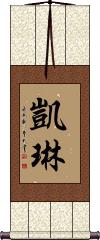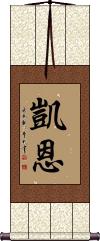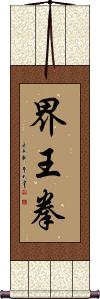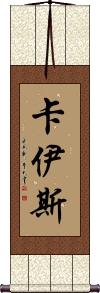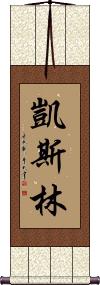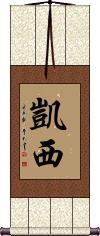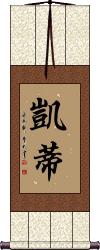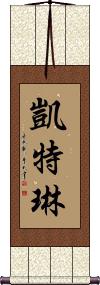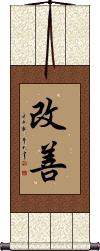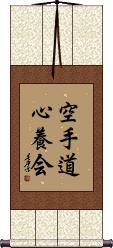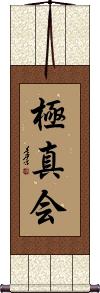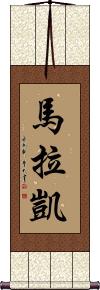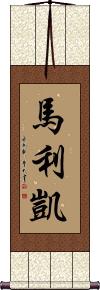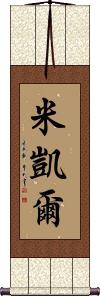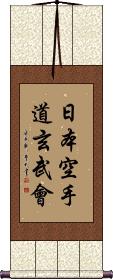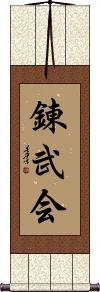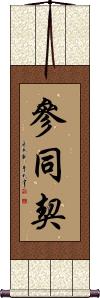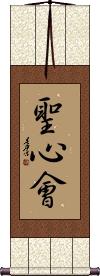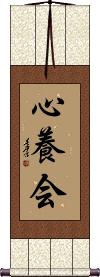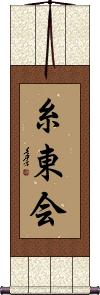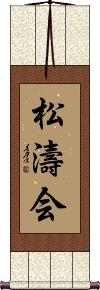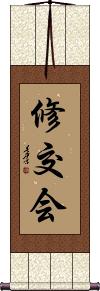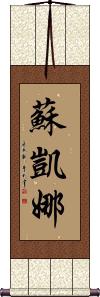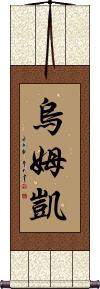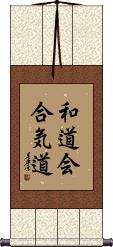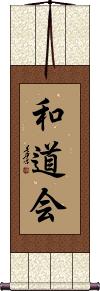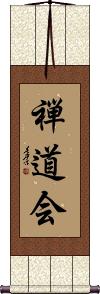The Name Kai in Japanese/Chinese on a Custom-Made Wall Scroll.
Click the "Customize" button next to your name below to start your personalized kai calligraphy artwork...
Switched to secondary search mode due to lack of results using primary.
These secondary results may not be very accurate. Try a different but similar meaning word or phrase for better results. Or...
Look up Kai in my Japanese Kanji & Chinese Character Dictionary(My dictionary is a different system then the calligraphy search you just tried)
If you want a special phrase, word, title, name, or proverb, feel free to contact me, and I will translate your custom calligraphy idea for you.
1. Aikikai
2. Akai
3. Budo-Kai
5. Bushi Kai
7. Goshin-Kai
9. Kai
10. Kaia
11. Kaicha
12. Kaici
13. Kaiden
14. Kaiesha
15. Kaijan
16. Kaiju
17. Kaila
18. Kailee
19. Kailena
20. Kailey
21. Kaili
22. Kailyn
23. Kain
24. Kaine
25. Kaio
26. Kaio-Ken
27. Kaira
28. Kairi
29. Kairon
30. Kais
31. Kaiselin
32. Kaishawn
33. Kaisie
34. Kaiti
35. Kaitlin
36. Kaitlyn
37. Kaity
38. Kaiya
39. Kai Zen / Kaizen
41. Kyokushinkai
42. Malakai
43. Malykai
45. Mikail
46. Nippon Karate-Do Genbu-Kai
48. Renbukai
49. Sandokai
51. Shinyo-Kai
52. Shitokai
53. Shotokai
54. Shukokai
55. Soka Gakkai
56. Soukaina
57. Sukaina
58. Umkai
59. Wado-Kai Aikido
60. Wado-Kai
61. Yushinkai
Aikikai
合気会 or “Aikikai” is the original school of Aikido.
Several organizations use this title. The first was established in Japan in 1940 (The Aikikai Foundation or 財団法人合気会).
The only difference between this title and Aikido is the last character, “kai” which means club, group, fraternity, organization, or assembly.
Note: 合気会 may be romanized with a dash like this: Aiki-Kai.
Akai
Budo-Kai
Budo Kai Jutsu
Bushi Kai
Dragon Ball Kai
ドラゴンボール改 is the name for Doragon Bōru Kai (Dragon Ball Revised), a high-definition remastered and recut of the original Dragon Ball Z, released on the 20th anniversary.
Note: Because this selection contains some special Japanese Katakana characters, it should be written by a Japanese calligrapher.
Goshin-Kai
Isshin-Kai / Isshinkai
一心会 is the Japanese martial arts title “Isshinkai” or “Isshin-Kai.”
It literally means “One Heart Association” or “Single-Heart Club.” This title is often associated with Isshin-Ryu Aikido and Isshin-Ryu Karate-Do. This title is appropriate for the name of a dojo that teaches these styles.
凱 is the transliteration to Mandarin Chinese for the name Kai.
This Chinese character means triumphant or victorious. In Chinese, it can be the surname, Kai.
Note: In Japanese this can be the given name Tanoshi.
Kaia
Kaia
Kaicha
Kaicha
Kaici
Kaici
Kaiden
Kaiden
Kaiesha
Kaiesha
Kaijan
Kaijan
Kaiju
Kaila
Kaila
Kailee
Kailee
Kailena
Kailena
Kailey
Kailey
Kaili
This is a common transliteration to Mandarin Chinese for the name Kaili.
It's also the name of Kaili city in Guizhou province.
I named my first daughter Kaili after visiting Kaili city and finding very friendly people there. I think this is a great English-Chinese baby name, as it is pronounceable in both languages, and the name works as a given name in both languages as well.
Kaili
Kailyn
Kailyn
Kain
Kain
Kaine
Kaine
Kaio
Kaio-Ken
Kaio-Ken
Kaira
Kaira
Kairi
Kairi
Kairon
Kairon
Kais
Kais
Kaiselin
Kaiselin
Kaishawn
Kaishawn
Kaisie
Kaisie
Kaiti
Kaiti
Kaitlin
Kaitlin
Kaitlyn
Kaitlyn
Kaity
Kaity
Kaiya
Kaiya
Kai Zen / Kaizen
改善 means betterment, improvement, to make better, or to improve - specifically incremental and continuous improvement.
改善 became very important in post-war Japan when Edwards Deming came to Japan to teach concepts of incremental and continuous improvement (for which the big 3 auto-makers did not want to hear about at the time - even kicking Deming out of their offices). The Japanese workforce absorbed this concept when their culture was in flux and primed for change.
This kaizen term is closely associated with the western title “Total Quality Management.” Perhaps dear to my heart since I spent years studying this at university before I moved to China where TQM did not seem to exist. Slowly, this concept has entered China as well (I've actually given lectures on the subject in Beijing).
If you are trying to improve processes at your business or need to remind yourself of your continuous TQM goals, this would be a great wall scroll to hang behind your desk or in your workplace.
See Also: Kansei
Karate-Do Shinyo-Kai
Kyokushinkai
Malakai
Malakai
Malykai
Malykai
Midori Yama Budokai
Mikail
Mikail
Nippon Karate-Do Genbu-Kai
Japanese Genbu Karate Club
日本空手道玄武會 is the title for Nippon Karate-Do Genbu-Kai.
A Japanese karate association of the Genbu school.
Note that while this title does make perfect sense in Chinese, it is really a Japanese title. In fact, the first word is “Japanese/Japan.”
If you’d like your martial arts school, dojo or club added to our calligraphy database for easy ordering of a custom calligraphy wall scroll, just contact me.
Nippon Karate Kyokai
Renbukai
Sandokai
Seishin-Kai / Seishinkai
聖心会 is the Japanese martial arts title “Seishinkai” or “Seishin-Kai.”
It literally means “Sacred Heart Association” or “Pure-Heart Club.”
聖 can mean holy, sacred, saint, sage, virtuous, expert, wise and good, upright, or correct.
心 can mean heart, mind, center, core, spirit, soul, or vitality.
聖心 creates a word meaning sacred heart, or the holy mind (that of Buddha).
会 in Japanese means association, club, meeting, assembly, party, gathering, conference, athletic meet, or society.
Shinyo-Kai
Shitokai
Shotokai
Shukokai
Soka Gakkai
Soukaina
Soukaina
Sukaina
Sukaina
Umkai
Umkai
Wado-Kai Aikido
Wado-Kai
Wado-Kai is used as a title for styles of Karate and Aikido.
Breaking down the characters into the proper Japanese Romaji, you have “wa dou kai” or “wa dō kai.” The meaning is roughly-translated as “Harmony Way Club” or “Peace Method Association.” The first Kanji should probably be read as harmony, rather than peace in this case.
See Also: Wado-Ryu
Yushinkai
友心会 is the martial arts title Yushinkai in Japanese Kanji.
This can translate as “Friendship Club” or “Friends Heart Club.”
Other possible titles that are romanized as Yushinkai are 有心会 and 結心会. These have a meaning that is more like Heartfelt Club or Heart-to-Heart Club. Be sure to check carefully to see what your school title is before you order. Let me know if you need one of these alternate versions.
Zen Do Kai / Zendokai
This is the martial arts title Zendokai.
The first two characters refer to Zen ascetic practices or Zen teachings. Noting that Zen or 禅 means meditation and Dou/Do or 道 means way.
Kai or 会 (originally written 會) in this context means society, association, or club.
Zendokai Karate beyond the normal fighting skills invites the practitioner to notice and observe their own body with mindfulness and self-awareness and can re-acquire and hone their genuine self.
The following table may be helpful for those studying Chinese or Japanese...
| Title | Characters | Romaji (Romanized Japanese) | Various forms of Romanized Chinese | |
| Aikikai | 合気会 / 合氣會 合気会 | ai ki kai / aikikai | ||
| Akai | 阿凱 阿凯 | ā kǎi / a1 kai3 / a kai / akai | a k`ai / akai / a kai | |
| Budo-Kai | 武道會 武道会 | bu dou kai / budoukai / bu do kai | ||
| Budo Kai Jutsu | 武道会術 | bu dou kai jutsu budoukaijutsu bu do kai jutsu | ||
| Bushi Kai | 武士會 武士会 | bu shi kai / bushikai | ||
| Dragon Ball Kai | ドラゴンボール改 | doragon bouru kai doragonbourukai doragon boru kai | ||
| Goshin-Kai | 護身会 护身会 | go shin kai goshinkai | ||
| Isshin-Kai Isshinkai | 一心会 / 一心會 一心会 | isshin kai / isshinkai / ishin kai | ||
| Kai | 凱 凯 | tanoshi | kǎi / kai3 / kai | k`ai / kai |
| Kai | カイ | kai | ||
| Kaia | 凱亞 凯亚 | kǎi yà / kai3 ya4 / kai ya / kaiya | k`ai ya / kaiya / kai ya | |
| Kaia | ケーア | keea / kea | ||
| Kaicha | 凱查 凯查 | kǎi chá / kai3 cha2 / kai cha / kaicha | k`ai ch`a / kaicha / kai cha | |
| Kaicha | カイチャ | kaicha | ||
| Kaici | 凱慈 凯慈 | kǎi cí / kai3 ci2 / kai ci / kaici | k`ai tz`u / kaitzu / kai tzu | |
| Kaici | カイシ | kaishi | ||
| Kaiden | 凱登 凯登 | kǎi dēng / kai3 deng1 / kai deng / kaideng | k`ai teng / kaiteng / kai teng | |
| Kaiden | カイデン | kaiden | ||
| Kaiesha | 凱沙 凯沙 | kǎi shā / kai3 sha1 / kai sha / kaisha | k`ai sha / kaisha / kai sha | |
| Kaiesha | カイエシャ | kaiesha | ||
| Kaijan | 凱揚 凯扬 | kǎi yáng / kai3 yang2 / kai yang / kaiyang | k`ai yang / kaiyang / kai yang | |
| Kaijan | カイジャン | kaijan | ||
| Kaiju | 怪獣 | kaijuu / kaiju | ||
| Kaila | 凱拉 凯拉 | kǎi lā / kai3 la1 / kai la / kaila | k`ai la / kaila / kai la | |
| Kaila | カイラ | kaira | ||
| Kailee | 凱莉 凯莉 | kǎi lì / kai3 li4 / kai li / kaili | k`ai li / kaili / kai li | |
| Kailee | ケーリー | keerii / keri | ||
| Kailena | 凱萊納 凯莱纳 | kǎi lái nà kai3 lai2 na4 kai lai na kailaina | k`ai lai na kailaina kai lai na |
|
| Kailena | カイレナ | kairena | ||
| Kailey | 凱利 凯利 | kǎi lì / kai3 li4 / kai li / kaili | k`ai li / kaili / kai li | |
| Kailey | ケイリー | keirii / keiri | ||
| Kaili | 凱里 凯里 | kǎi lǐ / kai3 li3 / kai li / kaili | k`ai li / kaili / kai li | |
| Kaili | カイリ | kairi | ||
| Kailyn | 凱琳 凯琳 | kǎi lín / kai3 lin2 / kai lin / kailin | k`ai lin / kailin / kai lin | |
| Kailyn | カイリン | kairin | ||
| Kain | 凱恩 凯恩 | kǎi ēn / kai3 en1 / kai en / kaien | k`ai en / kaien / kai en | |
| Kain | ケーン | keen / ken | ||
| Kaine | 凱恩 凯恩 | kǎi ēn / kai3 en1 / kai en / kaien | k`ai en / kaien / kai en | |
| Kaine | ケーン | keen / ken | ||
| Kaio | ケーオ | keeo / keo | ||
| Kaio-Ken | 界王拳 | kai ou ken / kaiouken / kai o ken | jiè wáng quán jie4 wang2 quan2 jie wang quan jiewangquan | chieh wang ch`üan chiehwangchüan chieh wang chüan |
| Kaio-Ken | 界王拳 | kai ou ken / kaiouken / kai o ken | jiè wáng quán jie4 wang2 quan2 jie wang quan jiewangquan | chieh wang ch`üan chiehwangchüan chieh wang chüan |
| Kaira | 凱拉 凯拉 | kǎi lā / kai3 la1 / kai la / kaila | k`ai la / kaila / kai la | |
| Kaira | カイラ | kaira | ||
| Kairi | 凱里 凯里 | kǎi lǐ / kai3 li3 / kai li / kaili | k`ai li / kaili / kai li | |
| Kairi | カイリー | kairii / kairi | ||
| Kairon | 凱倫 凯伦 | kǎi lún / kai3 lun2 / kai lun / kailun | k`ai lun / kailun / kai lun | |
| Kairon | カイロン | kairon | ||
| Kais | 卡伊斯 | qiǎ yī kǎ qia3 yi1 ka3 qia yi ka qiayika | ch`ia i k`a chiaika chia i ka |
|
| Kais | ケース | keesu / kesu | ||
| Kaiselin | 凱斯林 凯斯林 | kǎi sī lín kai3 si1 lin2 kai si lin kaisilin | k`ai ssu lin kaissulin kai ssu lin |
|
| Kaiselin | カイセリン | kaiserin | ||
| Kaishawn | 凱肖恩 凯肖恩 | kǎi xiào ēn kai3 xiao4 en1 kai xiao en kaixiaoen | k`ai hsiao en kaihsiaoen kai hsiao en |
|
| Kaishawn | カイショーン | kaishoon / kaishon | ||
| Kaisie | 凱西 凯西 | kǎi xī / kai3 xi1 / kai xi / kaixi | k`ai hsi / kaihsi / kai hsi | |
| Kaisie | ケイシー | keishii / keishi | ||
| Kaiti | 凱蒂 凯蒂 | kǎi dì / kai3 di4 / kai di / kaidi | k`ai ti / kaiti / kai ti | |
| Kaiti | カイティ | kaiti | ||
| Kaitlin | 凱特琳 凯特琳 | kǎi tè lín kai3 te4 lin2 kai te lin kaitelin | k`ai t`e lin kaitelin kai te lin |
|
| Kaitlin | ケイトリン | keitorin | ||
| Kaitlyn | 凱特琳 凯特琳 | kǎi tè lín kai3 te4 lin2 kai te lin kaitelin | k`ai t`e lin kaitelin kai te lin |
|
| Kaitlyn | ケイトリン | keitorin | ||
| Kaity | 凱蒂 凯蒂 | kǎi dì / kai3 di4 / kai di / kaidi | k`ai ti / kaiti / kai ti | |
| Kaity | ケイティ | keiti | ||
| Kaiya | 凱亞 凯亚 | kǎi yà / kai3 ya4 / kai ya / kaiya | k`ai ya / kaiya / kai ya | |
| Kaiya | カイヤ | kaiya | ||
| Kai Zen Kaizen | 改善 | kai zen / kaizen | gǎi shàn / gai3 shan4 / gai shan / gaishan | kai shan / kaishan |
| Karate-Do Shinyo-Kai | 空手道心養会 | kara te dou shin you kai karatedoushinyoukai kara te do shin yo kai | ||
| Kyokushinkai | 極真會 極真会 | kyoku shin kai kyokushinkai | ||
| Malakai | 馬拉凱 马拉凯 | mǎ lā kǎi ma3 la1 kai3 ma la kai malakai | ma la k`ai malakai ma la kai |
|
| Malakai | マラカイ | marakai | ||
| Malykai | 馬利凱 马利凯 | mǎ lì kǎi ma3 li4 kai3 ma li kai malikai | ma li k`ai malikai ma li kai |
|
| Malykai | マリカイ | marikai | ||
| Midori Yama Budokai | みどり山武道會 みどり山武道会 | mi do ri yama bu dou kai midoriyamabudoukai mi do ri yama bu do kai | ||
| Mikail | 米凱爾 米凯尔 | mǐ kǎi ěr mi3 kai3 er3 mi kai er mikaier | mi k`ai erh mikaierh mi kai erh |
|
| Mikail | ミカイル | mikairu | ||
| Nippon Karate-Do Genbu-Kai | 日本空手道玄武會 日本空手道玄武会 | ni ppon kara te dou gen bu kai nipponkaratedougenbukai ni pon kara te do gen bu kai | rì běn kōng shǒu dào xuán wǔ huì ri4 ben3 kong1 shou3 dao4 xuan2 wu3 hui4 ri ben kong shou dao xuan wu hui | jih pen k`ung shou tao hsüan wu hui jih pen kung shou tao hsüan wu hui |
| Nippon Karate Kyokai | 日本空手協會 日本空手協会 | nippon karate kyokai nipponkaratekyokai nipon karate kyokai | ||
| Renbukai | 錬武会 | renbukai | ||
| Sandokai | 參同契 | san dou kai sandoukai san do kai | cān tóng qì can1 tong2 qi4 can tong qi cantongqi | ts`an t`ung ch`i tsantungchi tsan tung chi |
| Seishin-Kai Seishinkai | 聖心会 / 聖心會 聖心会 | sei shin kai seishinkai | ||
| Shinyo-Kai | 心養會 心养会 / 心養会 | shin you kai shinyoukai shin yo kai | ||
| Shitokai | 糸東会 | shi tou kai shitoukai shi to kai | ||
| Shotokai | 鬆濤會 松濤会 | shou tou kai shoutoukai sho to kai | ||
| Shukokai | 修交会 / 修交會 修交会 | shuu kou kai shuukoukai shu ko kai | ||
| Soka Gakkai | 創価學會 創価学会 | souka gakkai soukagakkai soka gakai | ||
| Soukaina | 蘇凱娜 苏凯娜 | sū kǎi nà su1 kai3 na4 su kai na sukaina | su k`ai na sukaina su kai na |
|
| Soukaina | ソケーナ | sokeena / sokena | ||
| Sukaina | 蘇凱納 苏凯纳 | sū kǎi nà su1 kai3 na4 su kai na sukaina | su k`ai na sukaina su kai na |
|
| Sukaina | スカイナ | sukaina | ||
| Umkai | 烏姆凱 乌姆凯 | wū mǔ kǎi wu1 mu3 kai3 wu mu kai wumukai | wu mu k`ai wumukai wu mu kai |
|
| Umkai | ウンカイ | unkai | ||
| Wado-Kai Aikido | 和道會合気道 和道会合気道 | wa dou kai ai ki do wadoukaiaikido wa do kai ai ki do | ||
| Wado-Kai | 和道會 和道会 | wa dou kai / wadoukai / wa do kai | ||
| Yushinkai | 友心會 友心会 | yuu shin kai yuushinkai yu shin kai | ||
| Zen Do Kai Zendokai | 禅道会 | zen dou kai zendoukai zen do kai | ||
| In some entries above you will see that characters have different versions above and below a line. In these cases, the characters above the line are Traditional Chinese, while the ones below are Simplified Chinese. | ||||
